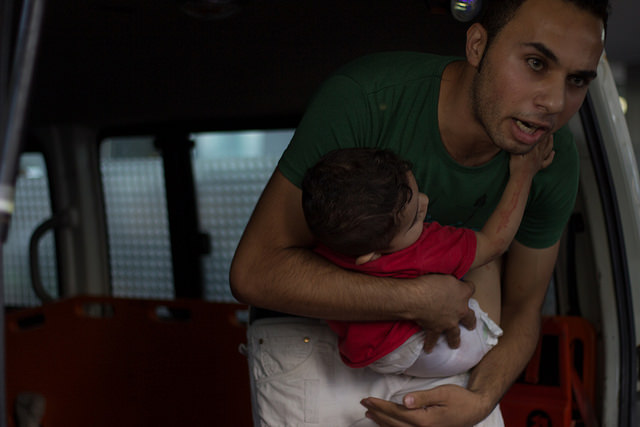This past summer Israel’s advanced military bombarded the tiny, impoverished and overpopulated Gaza Strip for a third time in six years. Consistent with past incursions, the toll on public infrastructure and civilian lives was immense.
Ultimately the seven-week bombardment caused a quarter of Gazans to flee their homes, becoming internally displaced persons within the Strip, while over 60,000 houses were either heavily damaged or destroyed. Agriculture and economic activity came to a standstill in an economy already ravaged by seven years of suffocating siege; food, water and electricity became even scarcer.
Nowhere was safe as schools, hospitals and mosques were targeted. Every man, woman and child lived in terror knowing that they could be hit at any moment.
In total 2,145 people were killed, the vast majority non-combatants, including 581 children. A further 11,000 were injured, many of who will remain physically disabled, putting further strain on families barely able to survive in Gaza’s siege economy.
Of the injured, 3,400 were children of whom 1,000 are now permanently disabled.
One response has been an attempt by Dr. Izzeldin Abuelaish to bring 100 severely injured children to Canada for medical treatment. He knows well the pain they and their families are experiencing. He recently came from Gaza to Canada after losing three daughters and a niece to a 2009 Israeli missile attack on his home during the first round of bombardments.
A Palestinian doctor who spent years treating patients both in Israel and the occupied Palestinian territories, he has channelled his anguish into forgiveness and peace activism.
Of the 100 children, he has said, “We need to help them, to heal them, not to be disabled. I want the voices of these children to be heard.”
But Stephen Harper’s government says no, refusing to grant these children visas.
Brutality of Israeli rule in Gaza
If you listen to those children, you will hear about a world that sounds more like a dystopian horror film than “normal” life.
In Gaza no Palestinian is safe. As Ayman Mohyeldin wrote, there are 1.8 million people in Gaza with stories of grief, loss and fear,
“Death comes at all hours of the day and night here. No one is safe and everyone is scared. There is a generation of Palestinians who have grown up here knowing three wars in a span of six years. They are not fighting the wars. But they are paying the price.”
It is tragically common for entire Gazan neighbourhoods to be levelled overnight, taking away the homes and lives of thousands of people that have nowhere to flee. Those homes are the shelter and sense of security children need to survive.
When thousands of explosive shells were used to destroy the Shujaiya residential neighbourhood on the eastern edge of Gaza in the summer, Israel shrugged off the civilian death toll claiming Hamas ordered the population to stay in their homes and be used as human shields. Some senior U.S. military officers believe though the use of force was purely brute and indiscriminate,
“Human shields? C’mon, just own up to it.”
Indiscriminate violence has long been though a part of every day Palestinian life. It is a rational tactic used by Israel to put pressure on the civilian population to achieve political goals, and is part of a broader process of dehumanisation necessary to carry out injustices against another human being.
Writing about a previous generation of Gazan children, Dr. James Graff said that between 1987 and 1993 a third had either been beaten or shot by Israeli soldiers. He mentioned a 1992 survey of Gazan’s aged eight to 15 in which 89 per cent had had their homes raided at night and 45 per cent were there subjected beatings. He described those child beatings where,
“Usually two, four or more soldiers are involved, using their rifles or army issued 60 cm plastic or fibreglass truncheons. They usually repeatedly strike their victims with these weapons all ‘over the body,’ often including the genitals, and they frequently kick or beat them with their fists as well. Other ‘standard’ beatings involve repeatedly smashing the victim’s head against walls or striking the victim on the forehead in order to cause a hairline fracture at the base of the skull.”
This was decades before Hamas rule and when the Strip’s population barely exceeded 600,000. Thus the child victims of today are themselves descended from the child victims of yesterday, their homes now invaded by missiles at night rather than marauding soldiers.
100 children denied
Unfortunately Gazan life has only gotten harder with time, including for the 375,000 children in need of immediate psychological care for trauma after the 2014 bombardment. Israel remains unwilling to help improve conditions for those children, solely blaming Hamas for the tragedy and calculating dead children as little more than propaganda pieces, which Israel’s Prime Minister described as “telegenically dead babies.”
Canada’s Prime Minister Stephen Harper seems to agree. Ignoring pleas from hospitals, health-care workers, the Ontario government and a petition by over 40,000 Canadians, his government refuses to grant the 100 visas Dr. Abuelaish needs.
Ultimately what Gaza’s children really need though is a political solution that protects Palestinian rights and ends a conflict that consistently feeds into tension around the world. Put into context, denying 100 visas to children in need of surgery is beyond petty.
But maybe Harper does not want their voices to be heard.
Jeremy Wildeman is a PhD candidate and political analyst with 12 years of experience delivering and conducting research on humanitarian programs for Palestinians in the occupied Palestinian territories.
Photo: flickr/Charity Organisation




